Probabilistic Analysis of Meat Distribution Logistics: Application of Monte Carlo Simulation
Abstract
1. Introduction
- (i)
- Planning: A detailed planning phase is essential to identify which products are appropriate for cross-docking operations, considering factors such as demand variability, physical characteristics, packaging requirements, and shelf life [11].
- (ii)
- Infrastructure adaptation: The physical infrastructure of the distribution center must be adequately modified to support cross-docking activities. This includes the establishment of designated zones for receiving, inspection, sorting, and rapid dispatch of goods, as well as the deployment of systems and equipment that enhance the speed and efficiency of material handling.
- (iii)
- Integration with supply chain partners: Effective implementation relies on robust communication and coordination among suppliers, the distribution center, and final customers. This level of integration ensures synchronized operations and minimizes bottlenecks throughout the supply chain [9].
- (iv)
- Monitoring and control: Continuous monitoring is vital to ensure real-time visibility and traceability of goods. Quality assurance, inventory management, and error prevention must be supported by the use of technological tools such as barcodes, Radio Frequency Identification (RFID), and integrated inventory management systems [9].
2. Literature Review
3. Materials and Methods
4. Results
4.1. Consumption and Demand Projection
4.2. Costs
4.3. Projected Cash Flow
4.4. Deterministic Analysis: Traditional EFA
- (i)
- The opportunity cost was set at 10%, representing the return foregone by allocating capital to this specific project rather than to a risk-free or low-risk alternative (e.g., government bonds and high-yield savings instruments).
- (ii)
- The business risk premium was also defined as 10%, capturing uncertainties specific to the sector, such as volatility in logistics costs, perishability of goods, regulatory constraints, and fluctuations in demand. This value is consistent with the literature that recommends a risk premium between 5% and 15% for projects in volatile or infrastructure-dependent industries [43,44].
- (iii)
- The Selic rate, Brazil’s official basic interest rate, was considered at its prevailing value of 13.75% at the time of analysis. This rate serves as a macroeconomic benchmark for the cost of capital in the country and is commonly used in discount rate composition for domestic investment projects.
4.5. Probabilistic Analysis: Monte Carlo Simulation
- (i)
- Market Share (%): Since this parameter reflects projected market penetration based on benchmarking or strategic expectations, the Pert distribution captures the associated uncertainty while emphasizing the central estimate.
- (ii)
- Operating Costs (BRL): These costs typically vary within a predictable range and are informed by operational plans and historical benchmarks. The Pert distribution is well suited to reflect this variability, especially when the most probable value is better understood than the extremes.
- (iii)
- Logistics Costs (BRL): Given their sensitivity to external factors such as fuel prices and transportation dynamics, logistics costs are inherently volatile. The Pert distribution accommodates this uncertainty, providing a more realistic representation of cost fluctuations.
- (iv)
- Minimum Attractive Rate of Return (MAR %): This rate reflects investor expectations and perceived risk. Its inherently subjective nature justifies modeling it with a Pert distribution to capture a central expectation while accounting for more conservative or optimistic scenarios.
- (v)
- Population Growth Rate (%): Although based on demographic projections, future population trends are subject to socioeconomic shifts. The Pert distribution effectively models this uncertainty within plausible bounds.
- (vi)
- IPCA (Inflation Index %): As a macroeconomic indicator, the IPCA is influenced by multiple factors and exhibits periodic fluctuations. Modeling it with the Pert distribution reflects market expectations and known variability patterns.
- (vii)
- Beef and Pork Consumption per Capita (kg/year): Consumption patterns are influenced by cultural, economic, and dietary factors. The Pert distribution captures the expected consumption while incorporating potential deviations due to behavioral or market changes.
- (viii)
- Percentage of the Meat-Consuming Population (%): This variable reflects societal and cultural trends, including dietary preferences. Given its relatively stable but not entirely deterministic behavior, the Pert distribution was chosen to account for expected shifts in consumer behavior.
- (i)
- Administrative Costs (BRL): These costs are generally more stable and often defined by contracts or internal budgets. The triangular distribution effectively models this variable with minimal complexity, reflecting the limited but structured uncertainty.
- (ii)
- Price Paid per Kilogram of Meat Distributed (BRL/kg): While subject to market conditions, this price can often be estimated with reasonable accuracy based on supplier agreements and recent price trends. The triangular distribution is thus appropriate for modeling its variation in a transparent and interpretable manner.
5. Discussion
6. Conclusions
Supplementary Materials
Author Contributions
Funding
Institutional Review Board Statement
Informed Consent Statement
Data Availability Statement
Acknowledgments
Conflicts of Interest
References
- FAO. Publicações. Available online: https://www.fao.org/brasil/pt/ (accessed on 2 May 2023).
- MAPA. Setor Alimentício. Available online: https://www.gov.br/agricultura/pt-br (accessed on 2 May 2023).
- CONAB. Oferta e Demanda de Carnes. 2023. Available online: https://www.conab.gov.br/info-agro/analises-do-mercado-agropecuario-e-extrativista/analises-do-mercado/oferta-e-demanda-de-carnes (accessed on 2 May 2023).
- Malafaia, G.C.; Biscola, P.H.N.; Dias, F.R.T. Neutralização de Carbono na Produção de Carne Bovina no Brasil e no Mundo. Embrapa Gado de Corte-Fôlder/Folheto/Cartilha (INFOTECA-E), 2020. Available online: https://sistemas.bambui.ifmg.edu.br/open_conference/index.php/jornadacientifica/jc2021/paper/view/377 (accessed on 2 May 2023).
- Ferreira, A.F.V.; Fontgalland, I.L. O mercado de carnes no contexto dos processos de inovação: O caso da empresa Tyson Foods. E-Acadêmica 2021, 2, e082231. [Google Scholar] [CrossRef]
- Miranda, M.V.P.; Ciribeli, J.P.; de Moraes Sarmento, C. Análise das perdas em produtos do supermercado nova era: Um estudo no setor alimentício de carnes, padaria e hortifrúti. Cad. Científico UNIFAGOC Grad. E. Pós-Grad. 2022, 7, 1. [Google Scholar]
- Buss, R.N.; Mendanha, J.F.; da Silva, D.M.; Siqueira, G.M. Infraestrutura logística de transporte e armazenagem da soja no estado do Maranhão–Brasil. Braz. J. Dev. 2019, 5, 31564–31580. [Google Scholar] [CrossRef]
- Vilamaior, A.G.; Parreira, G.C.; Moreira, G.S.; Palotti, I.A.P.; Ferreira, J.C.B. Análise dos custos de mão de obra direta no setor de abate e processamento de carnes do ifmg campus bambuí. In Proceedings of the XIII Jornada Científica, Online, 20 October 2021. [Google Scholar]
- Bartholdi, J.J.; Gue, K.R. Reducing Labor Costs in an LTL Crossdocking Terminal. Oper. Res. 2000, 48, 823–832. [Google Scholar] [CrossRef]
- Armlogistica. Crossdocking, o Que é e Como Ele Pode me Ajudar a Economizar em Frete. Available online: https://www.armlogistica.com.br/cross-docking-o-que-e-e-como-ele-pode-me-ajudar-a-economizar-em-frete (accessed on 2 May 2023).
- Fonseca, G.B.; Ravetti, M.G.; Nogueira, T.H. O Problema de Sequenciamento de Caminhões em um Centro de Crossdocking com Duas Máquinas; Universidade Federal de Minas Gerais: Belo Horizonte, Brazil, 2015. [Google Scholar]
- Brealey, R.A.; Myers, S.C.; Allen, F. Principles of Corporate Finance, 13th ed.; McGraw-Hill Education: New York, NY, USA, 2020. [Google Scholar]
- Copeland, T.E.; Koller, T.; Murrin, J. Valuation: Measuring and Managing the Value of Companies, 3rd ed.; John Wiley & Sons: Hoboken, NJ, USA, 2005. [Google Scholar]
- Monteiro, W.M.M.; Vasconcelos, M.W.M.; da Silva, T. Análise de viabilidade econômica de projetos hidrelétricos com uso da TIR e VPL. Rev. Bras. De Energ. 2021, 27, 55–67. [Google Scholar]
- Yao, Y.; Wang, Y.; Zhang, L. Application of financial assessment models in food production planning. J. Food Eng. 2021, 302, 110567. [Google Scholar] [CrossRef]
- Li, N.; Dong, L.W.; Zhao, L.M.; Gong, G.H.; Zhang, X. A credibility evaluation method for complex simulation systems based on interactive network analysis. Simul. Model. Pract. Theory 2021, 109, 102289. [Google Scholar] [CrossRef]
- Ferrari, C.S.; Bressan, G.N.; Silva, L.T. Otimização do processo de secagem de leite por simulação de Monte Carlo. Rev. Bras. Eng. Produção 2023, 23, 45–58. [Google Scholar]
- Griep-Moyer, E.R.; Trmčić, A.; Qian, C.; Moraru, C.I. Monte Carlo simulation model predicts bactofugation can extend shelf-life of pasteurized fluid milk, even when raw milk with low spore counts is used as the incoming ingredient. J. Dairy Sci. 2022, 105, 9439–9449. [Google Scholar] [CrossRef]
- Elsharkawy, A.M. Monte Carlo-based quality prediction for dairy products. J. Dairy Sci. 2021, 104, 7385–7394. [Google Scholar]
- Jang, H.; Park, Y.; Lee, J.H. Monte Carlo evaluation of hydrogen production investment under uncertainty. Energy Policy 2022, 160, 112702. [Google Scholar] [CrossRef]
- Wealer, B.; Bauer, C.; Landry, J.S. Risk analysis in nuclear energy investments using Monte Carlo simulation. Energy Econ. 2021, 98, 105278. [Google Scholar] [CrossRef]
- Shahid, M.; Alam, T.; Baig, M.A. Robust planning in agro-industries with Monte Carlo methods. Agric. Syst. 2022, 196, 103302. [Google Scholar] [CrossRef]
- Kovács, K.; Szűcs, I. Exploring efficiency reserves in Hungarian milk production. Stud. Agric. Econ. 2020, 122, 37–43. [Google Scholar] [CrossRef]
- Pedolin, D.A.; Schmid, A.; Vázquez-Rowe, I. Environmental efficiency of Swiss agriculture: A combined DEA-LCA approach. J. Clean. Prod. 2021, 317, 128345. [Google Scholar] [CrossRef]
- Barros, G.S.; Santana, R.H.; Marques, V.S. Sustainability and productivity in Brazilian dairy farms. Sustainability 2022, 14, 11745. [Google Scholar] [CrossRef]
- De Melo, G.A.; Peixoto, M.G.M.; Barbosa, S.B.; Alves, A.J.S.; Souza, A.C.L.; Mendonça, M.C.A.; de Castro Júnior, L.G.; Santos, P.G.D.; Serrano, A.L.M.; Neumann, C. Generating insights to improve the performance of communities supported agriculture: An analysis focused on female participation, governance structure and volume of food distributed. Environ. Dev. Sustain. 2024, 1–19. [Google Scholar] [CrossRef]
- De Melo, G.A.; Peixoto, M.G.M.; Barbosa, S.B.; Alves, A.J.S.; Souza, A.C.L.; Mendonça, M.C.A.; de Castro Júnior, L.G.; Santos, P.G.D.; Serrano, A.L.M.; Neumann, C. Fuel flow logistics: An empirical analysis of performance in a network of gas stations using principal component analysis and data envelopment analysis. J. Adv. Manag. Res. 2024, 21, 605–626. [Google Scholar] [CrossRef]
- Zhang, C.; Gong, Y.; Brown, S. Research methodology. In Blockchain Applications in Food Supply Chain Management: Case Studies and Implications; Springer: Cham, Switzerland, 2023; pp. 77–98. [Google Scholar]
- Bogataj, D.; Hudoklin, D.; Bogataj, M.; Dimovski, V.; Colnar, S. Risk Mitigation in a Meat Supply Chain with Options of Redirection. Sustainability 2020, 12, 8690. [Google Scholar] [CrossRef]
- Blagojevic, B.; Nesbakken, T.; Alvseike, O.; Vågsholm, I.; Antic, D.; Johler, S.; Houf, K.; Meemken, D.; Nastasijevic, I.; Pinto, M.V.; et al. Drivers, opportunities, and challenges of the European risk-based meat safety assurance system. Food Control 2021, 124, 107870. [Google Scholar] [CrossRef]
- Modzelewska-Kapituła, M.; Jun, S. The application of computer vision systems in meat science and industry—A review. Meat Sci. 2022, 192, 108904. [Google Scholar] [CrossRef]
- Gholami-Zanjani, S.M.; Jabalameli, M.S.; Pishvaee, M.S. A resilient-green model for multi-echelon meat supply chain planning. Comput. Ind. Eng. 2021, 152, 107018. [Google Scholar] [CrossRef]
- Baležentis, T.; Morkūnas, M.; Žičkienė, A.; Volkov, A.; Ribašauskienė, E.; Štreimikienė, D. Policies for rapid mitigation of the crisis’ effects on agricultural supply chains: A multi-criteria decision support system with Monte Carlo simulation. Sustainability 2021, 13, 11899. [Google Scholar] [CrossRef]
- De Melo, G.A.; Paes, T.F.A.; da Costa, J.S.; Silva, C.S.J.E.; de Castro Júnior, L.G.; Gomide, L.R.; Peixoto, M.G.M.; Guarnieri, P.; Barbosa, S.B.; Serrano, A.L.M. Optimizing forest sector performance based on life cycle cost analysis and real options. Sci. Total Environ. 2025, 988, 179675. [Google Scholar] [CrossRef] [PubMed]
- Peixoto, M.G.M.; Musetti, M.A.; de Mendonça, M.C.A. Performance management in hospital organizations from the perspective of Principal Component Analysis and Data Envelopment Analysis: The case of Federal University Hospitals in Brazil. Comput. Ind. Eng. 2020, 150, 106873. [Google Scholar] [CrossRef]
- Peixoto, M.G.M.; Mendonça, M.C.A.; Castro, C.C.; de Castro, L.G.J.; de Melo, G.A.; Batalha, M.O. Evaluation of the operational efficiency of southeast intermodal terminals in the grain logistics chain using data envelopment analysis. Manag. Decis. Econ 2022, 43, 3044–3058. [Google Scholar] [CrossRef]
- Alves de Melo, G.; Peixoto, M.G.M.; Barbosa, S.B.; de Mendonça, M.C. The analysis of macro processes of the cashier service in a supermarket organization: A case study of quality management and simulation. Dyna 2022, 89, 19–26. [Google Scholar] [CrossRef]
- De Melo, G.A.; Peixoto, M.G.M.; Mendonça, M.C.A.; Musetti, M.A.; Serrano, A.L.M.; Ferreiraet, L.O.G. Performance measurement of Brazilian federal university hospitals: An overview of the public health care services through principal component analysis. J. Health Organ. Manag. 2024, 38, 351–371. [Google Scholar] [CrossRef]
- IBGE. Cidades. Available online: https://cidades.ibge.gov.br (accessed on 2 May 2023).
- Agência Brasil. No Brasil, 14% da População se Considera Vegetariana. Available online: https://agenciabrasil.ebc.com.br/saude/noticia/2021-10/no-brasil-14-da-populacao-se-considera-vegetariana (accessed on 2 May 2023).
- Apte, U.M.; Viswanathan, S. Effective Cross Docking for Improving Distribution Efficiencies. Int. J. Logist. Res. Appl. 2000, 3, 291–302. [Google Scholar] [CrossRef]
- ANTT. Agência Nacional de Transportes Terrestres (ANTT) Divulga Novos Valores da Tabela de Pisos Mínimos de Frete. Available online: https://www.gov.br/antt/pt-br/assuntos/ultimas-noticias/antt-divulga-novos-valores-da-tabela-de-pisos-minimos-de-frete (accessed on 2 May 2023).
- Benetti, C.; Terra, P.R.S.; Decourt, R.F. Financial Management in Practice: Analysis of Brazilian Survey Data. Rev. Adm. Contemp. 2022, 26, e200419. [Google Scholar] [CrossRef]
- Martins, E.; Galdi, F.C.; de Lima, G.A.S.F.; Necyk, G.A.; Abe, C.H.S. Empirical Evidence for Models to Estimate the Cost of Equity Capital. Braz. Bus. Rev. 2006, 3, 135–152. [Google Scholar] [CrossRef]
- Guchhait, R.; Sarkar, M.; Sarkar, B.; Yang, L.; AlArjani, A.; Mandal, B. Extended material requirement planning (MRP) within a hybrid energy-enabled smart production system. J. Ind. Inf. Integr. 2024, 42, 100717. [Google Scholar] [CrossRef]
- Jeffer, S.B.; Kassem, I.I.; Kharroubi, S.A.; Abebe, G.K. Analysis of Food Safety Management Systems in the Beef Meat Processing and Distribution Chain in Uganda. Foods 2021, 10, 2244. [Google Scholar] [CrossRef]
- Ren, Q.-S.; Fang, K.; Yang, X.-T.; Han, J.-W. Ensuring the quality of meat in cold chain logistics: A comprehensive review. Trends Food Sci. Technol. 2022, 119, 133–151. [Google Scholar] [CrossRef]
- Botilias, G.-P.; Margariti, S.V.; Besarat, J.; Salmas, D.; Pachoulas, G.; Stylios, C.; Skalkos, D. Designing and Developing a Meat Traceability System: A Case Study for the Greek Meat Industry. Sustainability 2023, 15, 12162. [Google Scholar] [CrossRef]
- Vostriakova, V.; Kononova, O.; Kravchenko, S.; Ruzhytskyi, A.; Sereda, N. Optimization of agri-food supply Chain in a sustainable way using simulation modeling. Int. J. Comput. Sci. Netw. Secur. 2021, 21, 245–256. [Google Scholar]

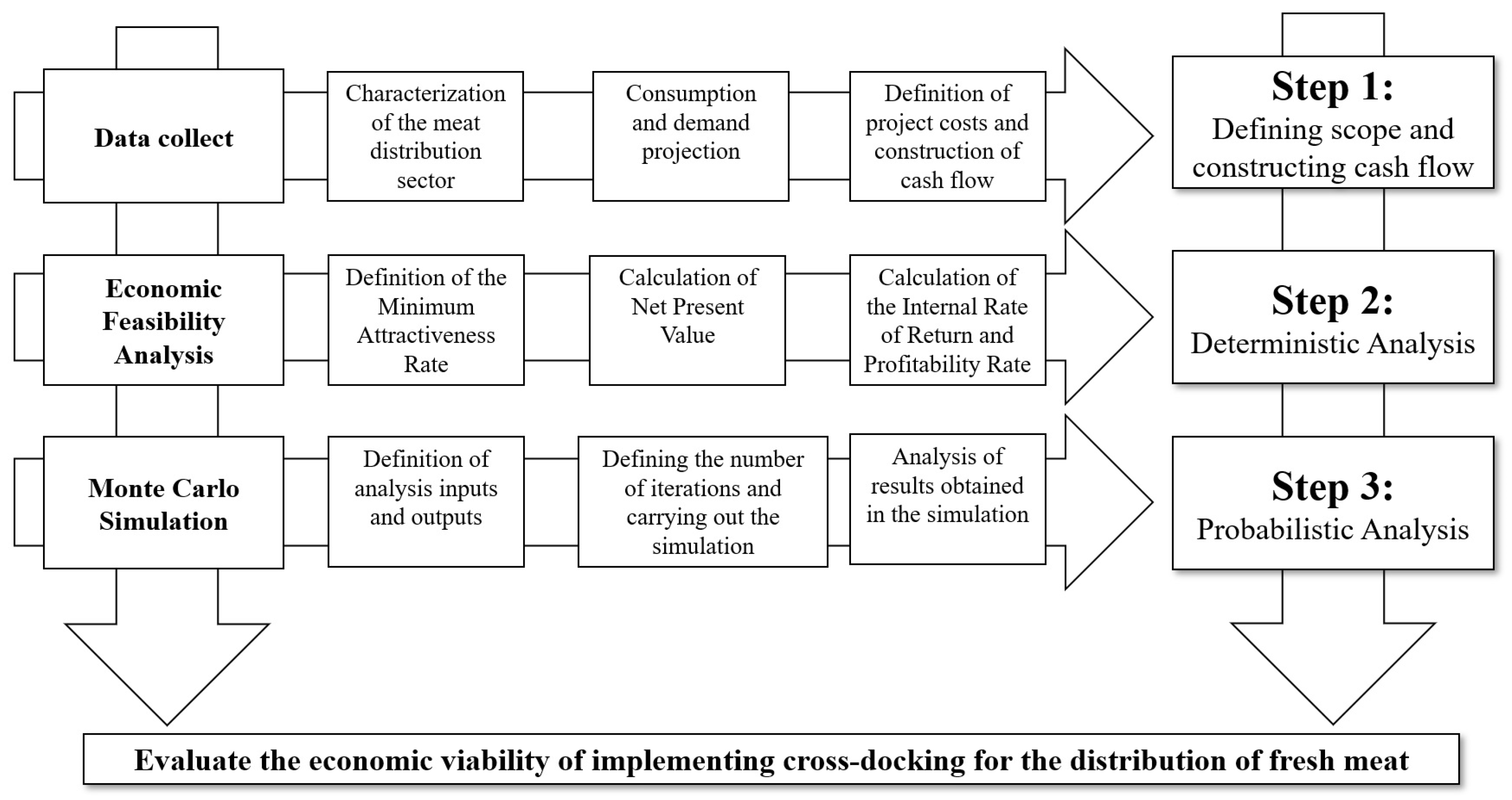
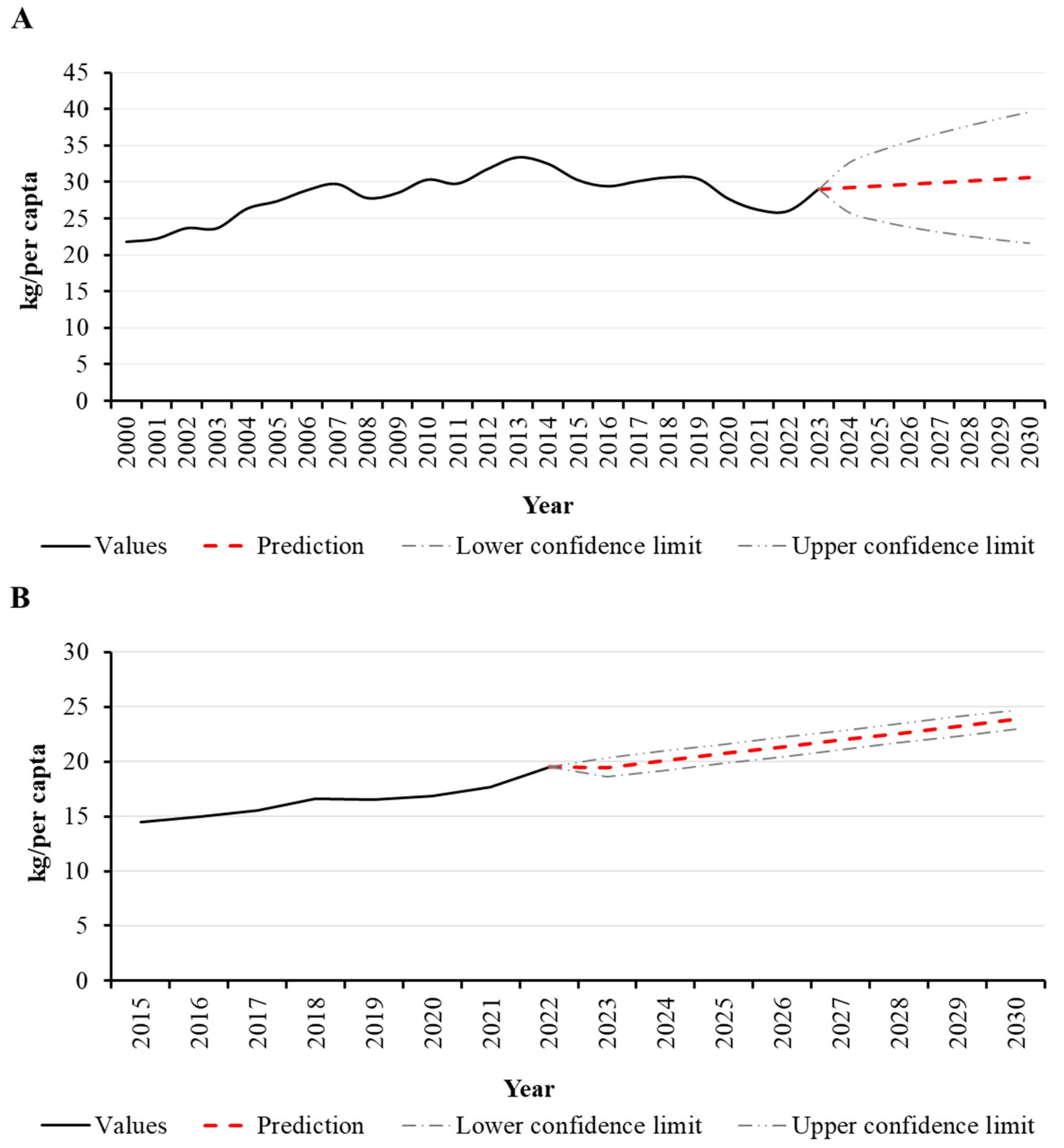


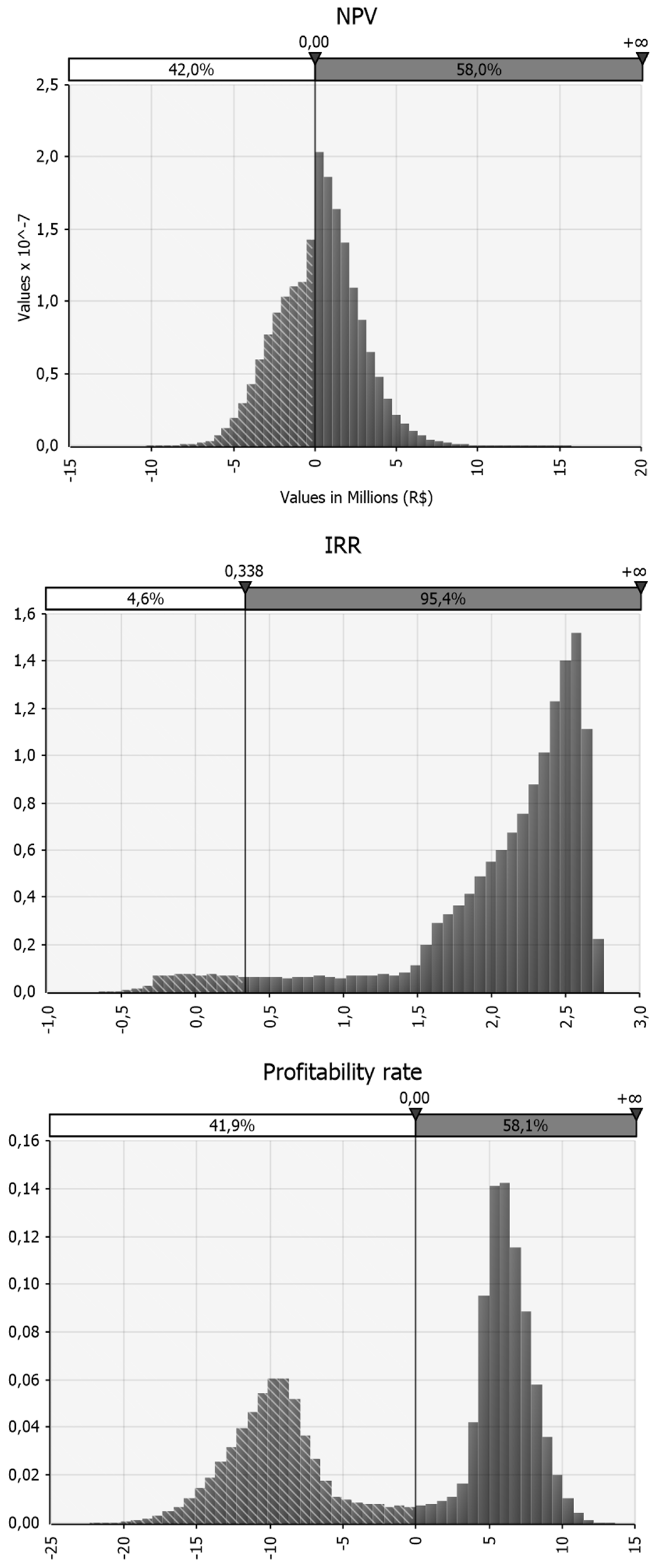
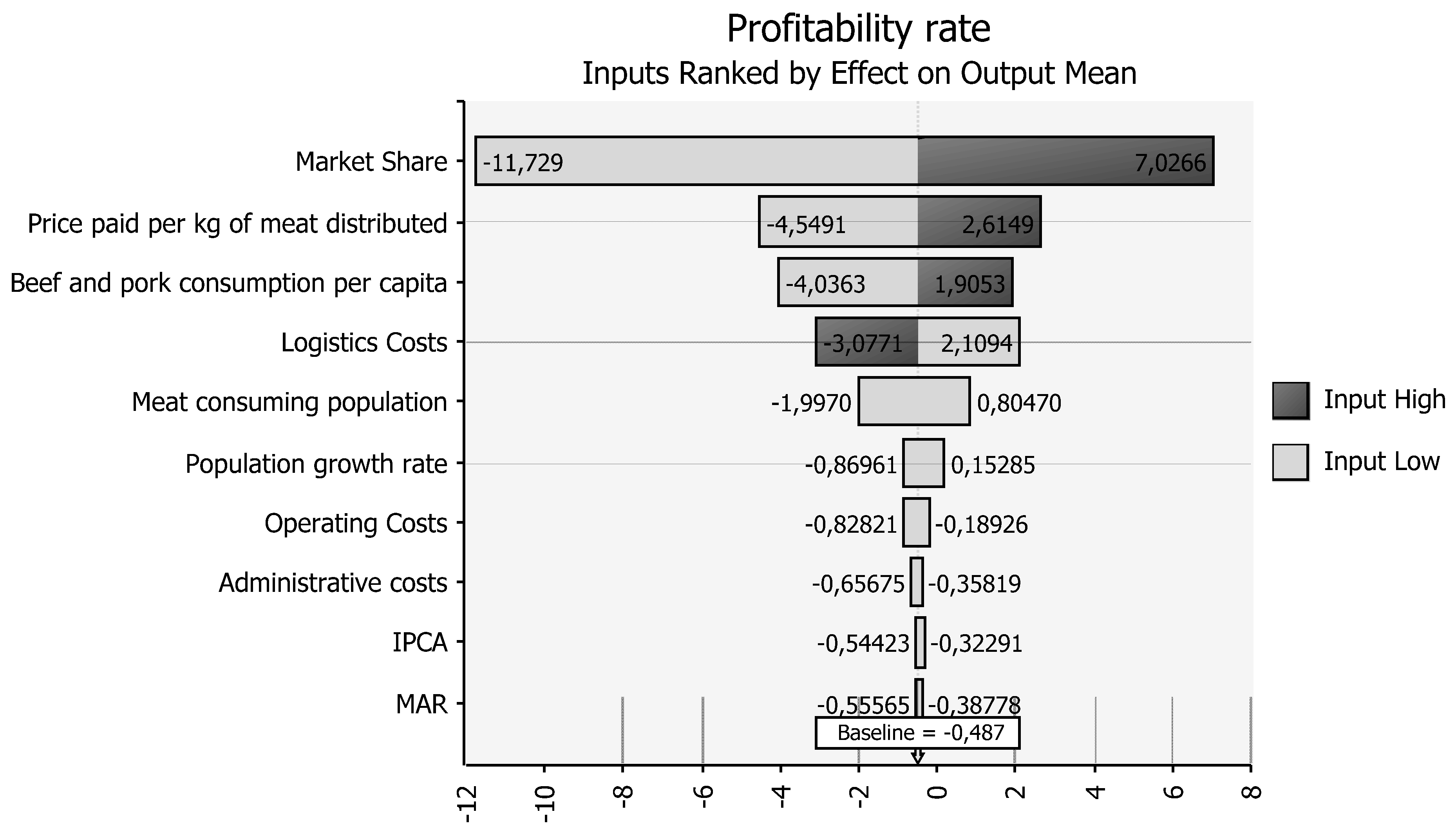
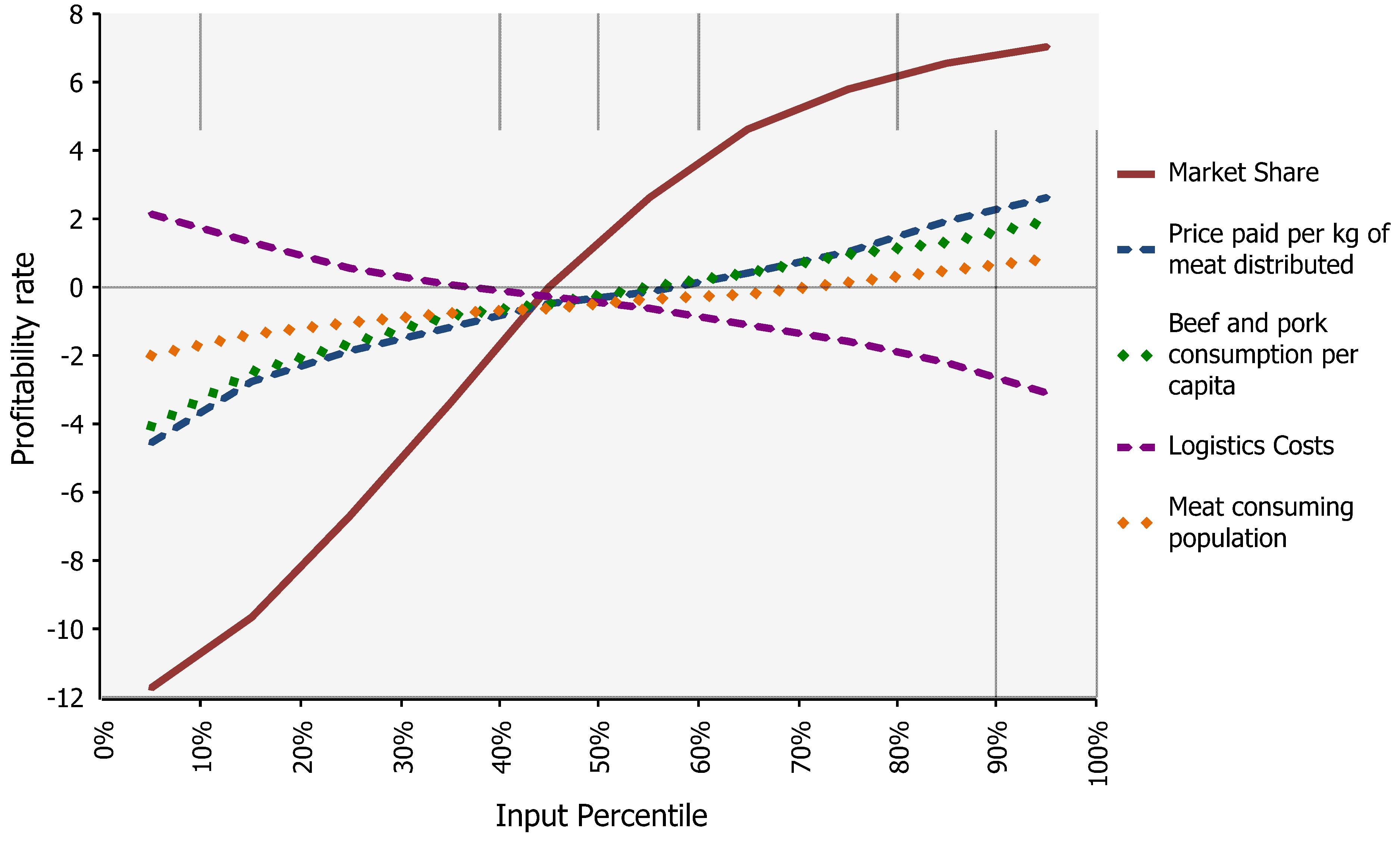
| Total Pork and Beef Consumption Projected for Southern Minas Gerais | ||||
|---|---|---|---|---|
| Year | Projected Annual Population for Southern Minas Gerais | Annual Meat-Consuming Population in Southern Minas Gerais (kg) | Projected per Capita Meat Consumption (kg.per Capta.Year) | Projected Total Meat Consumption (t) |
| 2023 | 2,875,304 | 2,472,761 | 48.46 | 119,841.5 |
| 2024 | 2,896,581 | 2,491,060 | 49.32 | 122,855.5 |
| 2025 | 2,918,016 | 2,509,494 | 50.17 | 125,907.6 |
| 2026 | 2,939,609 | 2,528,064 | 51.03 | 128,998.1 |
| 2027 | 2,961,362 | 2,546,771 | 51.88 | 132,127.5 |
| 2028 | 2,983,276 | 2,565,618 | 52.73 | 135,296.1 |
| 2029 | 3,005,352 | 2,584,603 | 53.59 | 138,504.4 |
| 2030 | 3,027,592 | 2,603,729 | 54.44 | 141,752.7 |
| Total Pork and Beef Demand Projected for Southern Minas Gerais | ||
|---|---|---|
| Year |
Projected Total Meat Consumption (t) | Projected Total Demand for the Stipulated Market Share (t) |
| 2023 | 119,841.5 | 4793.7 |
| 2024 | 122,855.5 | 4914.2 |
| 2025 | 125,908 | 5036.3 |
| 2026 | 128,998.1 | 5159.9 |
| 2027 | 132,127.5 | 5285.1 |
| 2028 | 135,296.1 | 5411.8 |
| 2029 | 138,504.4 | 5540.2 |
| 2030 | 141,753 | 5670.1 |
| Cost 2024 | |
|---|---|
| Cost Type | Value |
| Operating costs | BRL 238,046 |
| Logistics costs | BRL 2,822,658 |
| Cost of structure (yard + cold room + energy/water) | BRL 16,380 |
| Administrative costs | BRL 19,700 |
| Total cost per kg | BRL 0.63 |
| Period | Cash Flow | Discounted Cash Flow | Balance |
|---|---|---|---|
| 0 | −BRL 62,518 | −BRL 62,518 | −BRL 62,518 |
| 1 | BRL 89,581 | BRL 66,315 | BRL 3796 |
| 2 | BRL 145,559 | BRL 79,768 | BRL 83,564 |
| 3 | BRL 159,190 | BRL 64,580 | BRL 148,144 |
| 4 | BRL 194,635 | BRL 58,452 | BRL 206,596 |
| 5 | BRL 230,553 | BRL 51,255 | BRL 257,852 |
| 6 | BRL 266,947 | BRL 43,932 | BRL 301,785 |
| 7 | BRL 303,821 | BRL 37,015 | BRL 338,800 |
| Economic Indicators | |
|---|---|
| Sum VPs | BRL 401,319 |
| NPV | BRL 338,800 |
| IRR | 181.42% |
| Profitability rate | 6.42 |
| Payback | 0.94 |
| Inputs | Distribution | Parameters |
|---|---|---|
| Market share (%) | Pert | (2%; 4%; 8%) |
| Operating costs (BRL) | Pert | (3; 5; 7) |
| Logistics costs (BRL) | Pert | (2,258,127; 2,822,659; 3,387,190) |
| Administrative costs (BRL) | Triangular | (19,700; 22,600; 26,000) |
| Price paid per kg of meat distributed (BRL/kg) | Triangular | (0.50; 0.66; 0.80) |
| MAR | Pert | (13.75; 33,75; 50) |
| Population growth rate (%) | Pert | (0.005; 0.0074; 0.015) |
| IPCA (%) | Pert | (0.02; 0.0316; 0.05) |
| Beef and pork per capita consumption (kg/per capta/year) | Pert | (35; 49.32; 55) |
| Percentage of the meat-consuming population (%) | Pert | (0.774; 0.86; 0.946) |
| Inputs | Target for a Profitability Rate = 80% |
|---|---|
| Market Share (%) | 4.50% |
| Logistics costs (BRL) | BRL 2,240,790 |
| Price paid per kg of meat distributed (BRL/kg) | BRL 0.79 |
| Beef and pork per capita consumption (kg/per capta/year) | 58.456 |
| Percentage of meat-consuming population (%) | 105% |
Disclaimer/Publisher’s Note: The statements, opinions and data contained in all publications are solely those of the individual author(s) and contributor(s) and not of MDPI and/or the editor(s). MDPI and/or the editor(s) disclaim responsibility for any injury to people or property resulting from any ideas, methods, instructions or products referred to in the content. |
© 2025 by the authors. Licensee MDPI, Basel, Switzerland. This article is an open access article distributed under the terms and conditions of the Creative Commons Attribution (CC BY) license (https://creativecommons.org/licenses/by/4.0/).
Share and Cite
de Melo, G.A.; de Castro Júnior, L.G.; Peixoto, M.G.M.; Barbosa, S.B.; Serrano, A.L.M.; Campos, C.C.F.; Vanzela, M.; Delai, A.P.D. Probabilistic Analysis of Meat Distribution Logistics: Application of Monte Carlo Simulation. Logistics 2025, 9, 166. https://doi.org/10.3390/logistics9040166
de Melo GA, de Castro Júnior LG, Peixoto MGM, Barbosa SB, Serrano ALM, Campos CCF, Vanzela M, Delai APD. Probabilistic Analysis of Meat Distribution Logistics: Application of Monte Carlo Simulation. Logistics. 2025; 9(4):166. https://doi.org/10.3390/logistics9040166
Chicago/Turabian Stylede Melo, Gustavo Alves, Luiz Gonzaga de Castro Júnior, Maria Gabriela Mendonça Peixoto, Samuel Borges Barbosa, André Luiz Marques Serrano, Caroline Cambraia Furtado Campos, Matheus Vanzela, and Ana Paula Dalmagro Delai. 2025. "Probabilistic Analysis of Meat Distribution Logistics: Application of Monte Carlo Simulation" Logistics 9, no. 4: 166. https://doi.org/10.3390/logistics9040166
APA Stylede Melo, G. A., de Castro Júnior, L. G., Peixoto, M. G. M., Barbosa, S. B., Serrano, A. L. M., Campos, C. C. F., Vanzela, M., & Delai, A. P. D. (2025). Probabilistic Analysis of Meat Distribution Logistics: Application of Monte Carlo Simulation. Logistics, 9(4), 166. https://doi.org/10.3390/logistics9040166






